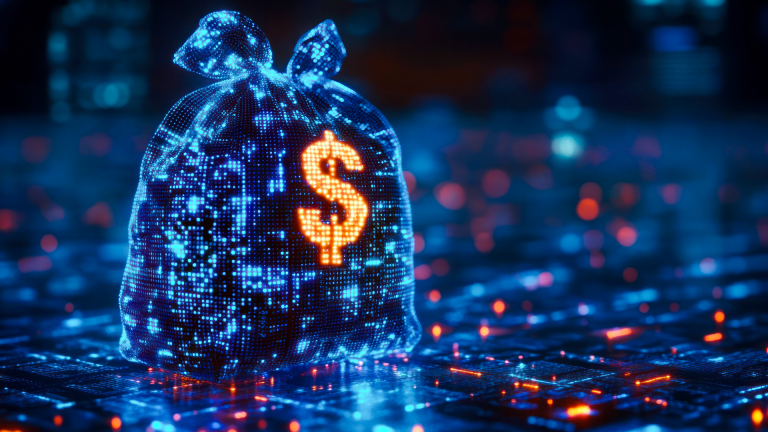Editor’s note: “Say Hello to the $400 Billion AI Bazooka Aimed at the Market” was previously published in September 2025. It has since been updated to include the most relevant information available.
The skeptics are out in force. They’ve got charts, historical parallels, and breathless warnings about bubbles, overvaluation, and “too much too soon.” They’ve got a laundry list of reasons why AI stocks can’t keep soaring.
I’ve got one reason why they’re all wrong…
It’s shockingly simple: Most money in the modern economy is going to AI.
That reason behind this AI delegation is why AI stocks have been soaring, and it’s why they’ll keep soaring.
And when you follow the money, the trail doesn’t just point to AI – it leads straight to the beating heart of the global economy itself.
Big Tech Is the Global Economy
Let’s stop pretending otherwise: Big Tech doesn’t just influence the global economic order – they are the global economic order.
Nvidia (NVDA), Microsoft (MSFT), Apple (AAPL), Alphabet (GOOGL), Amazon (AMZN), Meta (META), Broadcom (AVGO), Taiwan Semiconductor (TSM), Tesla (TSLA) – the valuations alone tell the story.
All are trillion-dollar companies. If Nvidia and Microsoft were countries, they would rank as the fifth and sixth largest economies in the world, bigger than India, the U.K., France, Italy, Brazil, Canada, Russia, and Mexico.
And these are the behemoths that are going all-in on AI spending.
Not dabbling or cautiously allocating. They’re loading up a financial superweapon – what I call the AI Bazooka – and firing it almost exclusively at expanding AI infrastructure.
The AI Capex Explosion
The numbers are staggering. Let’s start with Meta.
In 2022, the company spent about $32 billion on servers and data centers. This year, analysts expect spending to approach $40- to $45 billion, with AI infrastructure being the biggest driver.
And it isn’t alone.
Microsoft’s annual capex has nearly doubled since the pandemic, topping $50 billion, and guidance suggests it could push higher as AI cloud demand accelerates.
Alphabet has boosted annual capex from roughly $25 billion in 2021 to more than $50 billion in 2025, with a majority directed at AI compute and data centers.
Amazon remains the heavyweight: consensus estimates peg AWS-related spending above $70 billion this year.
Together, the “Hyperscale Five” are projected to exceed $250- to $300 billion in annual AI-related capex – a dramatic leap from under $150 billion in 2022.

That means that in less than three years, we’ve seen a 2.5x increase – and it’s still accelerating. Just look at that chart above. Like AI stock prices, it’s going vertical.
What Makes This Different From Any Other Spending Cycle
Tech spending cycles are nothing new. But this is different in three important ways:
- The Scale – These companies aren’t just big. They are the largest profit-generating entities in human history. Their capex increases aren’t measured in percentages. They’re measured in entire GDPs of small countries.
- The Focus – Nearly every incremental dollar is going into AI infrastructure – data centers, chips, networking, power, cooling. One sector, full blast.
- The Flywheel – AI infrastructure enables better AI models, which drive more products, which generate more revenue, which funds more infrastructure. This is compounding growth in action.
That’s why I call it the AI Bazooka. It’s the concentrated firepower of the world’s richest corporations, aimed squarely at one target: AI dominance.
Where the AI Bazooka Money Lands
All that money has to find a home, and Wall Street has been more than happy to receive it. The beneficiaries are spread across the entire AI supply chain.
- Raw Materials: Rare earths supplier MP Materials (MP) is up 315% in the past year.
- Chips & Foundries: Nvidia up more than 600% in five years; Taiwan Semi has risen about 250% since ChatGPT’s launch in November 2022 and is hitting record revenues (~$30.1 billion).
- Memory & Storage: Micron (MU), Western Digital (WDC), Seagate (STX) are all breaking 52-week highs.
- Semiconductor Equipment: ASML (ASML), Lam Research (LRCX), Applied Materials (AMAT) are selling the pickaxes in this gold rush.
- Networking & Optics: Astera Labs (ALAB) – up nearly 165% since April – Arista (ANET), Marvell (MRVL), Rambus (RMBS) are critical for AI’s high-speed data pipes.
- Power & Cooling: Vistra (VST), Quanta Services (PWR), and Eaton (ETN) benefit as data centers strain grids and cooling demand surges.
This is the blast radius of the AI Bazooka. These stocks have been winning, and so long as the bazooka keeps firing, they’ll keep rising.
Why This AI Spending Boom Won’t Stop
The big question: Is this just a temporary surge, or a sustained trend?
Our view: It’s only just getting started.
Over $400 billion is expected to pour into AI infrastructure in the next 12 months. By 2030, analysts expect annual AI-related capex to approach $1 trillion. The more compute power deployed, the more indispensable AI becomes. This cycle reinforces itself.
So, when pundits say AI stocks can’t keep going up, they’re ignoring the single biggest capital allocation trend in the world.
It’s not just that Big Tech wants to dominate AI. They must. The competitive stakes are existential. The company with the most compute wins the AI race. That’s why they’re emptying their vaults into chips, data centers, and power grids.
Wall Street isn’t dumb. It follows the money. And right now, the money – all the money – is headed into AI.
The Bottom Line on AI Stocks
The AI Bazooka is locked, loaded, and firing hundreds of billions of dollars into one of the most powerful technological buildouts in history. The winners are clear: AI infrastructure stocks, from chipmakers to cooling providers, are riding the blast wave.
As long as Big Tech keeps spending (and they will), these stocks will keep ripping higher. The skeptics can cling to their valuation charts and bubble metaphors. The rest of us will follow the money.
Because in this market, the AI Bazooka always finds its target.
But it isn’t just aimed at chips and data centers…
It’s about to fire into humanoid robotics, with Tesla’s Optimus leading the charge. Morgan Stanley estimates this market could be worth trillions. But the biggest windfall won’t come from Tesla; it’ll come from the small, little-known suppliers making the actuators, sensors, and semiconductors that bring these machines to life.
If you want to be in front of the blast wave – not behind it – now’s the time to see which names are in the crosshairs.
Click here to see my full briefing before the AI Bazooka fires again.

